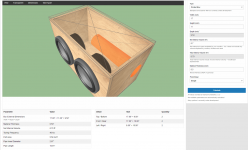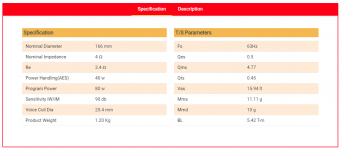Hi I am working on a Bluetooth stereo system, please help me with these doubts.
1. Fs of my woofer speaker is 63Hz, so can I tune the enclosure to 40Hz or low?
If no, at what frequency should I design!
2. Two woofers can share the same enclosure volume, since they are same spec and receiving the same signal?
3. Adding a speaker cloth cover in front of the port hole will affect the bass output and tuning!!?
Woofer spec: 6inch 4ohm woofer, 40Watt RMS, Peak 80Watt, 2Nos
Fs= 63Hz, Qes= 0.5, Qms= 4.77, Qts= 0.45, Vas= 15.94ltr
Tweeter: 10Watt, 4ohm, 2Nos
Amplifier: tpa3116d2, 2*80Watt
Thank you
1. Fs of my woofer speaker is 63Hz, so can I tune the enclosure to 40Hz or low?
If no, at what frequency should I design!
2. Two woofers can share the same enclosure volume, since they are same spec and receiving the same signal?
3. Adding a speaker cloth cover in front of the port hole will affect the bass output and tuning!!?
Woofer spec: 6inch 4ohm woofer, 40Watt RMS, Peak 80Watt, 2Nos
Fs= 63Hz, Qes= 0.5, Qms= 4.77, Qts= 0.45, Vas= 15.94ltr
Tweeter: 10Watt, 4ohm, 2Nos
Amplifier: tpa3116d2, 2*80Watt
Thank you

Hi Deric,
1: possibly, but a few extra bits of info would be helpful: first, do you have any limits on the enclosure size & shape? Second, do you know the parameters "Sd" & "Xmax" for the driver? Third, how loud do you think you want to be able to play as tuning lower often results in tradeoffs w.r.t. maximum volume. From the info you've got so far, I'd say that tuning between 45 & 50Hz would probably be better than pushing all the way down to 40.
2, yes, that is correct.
3: not if the cloth is designed for use as a speaker grille as it will be thin & open enough that the air can pass through it without much impedance.
HTH,
David.
1: possibly, but a few extra bits of info would be helpful: first, do you have any limits on the enclosure size & shape? Second, do you know the parameters "Sd" & "Xmax" for the driver? Third, how loud do you think you want to be able to play as tuning lower often results in tradeoffs w.r.t. maximum volume. From the info you've got so far, I'd say that tuning between 45 & 50Hz would probably be better than pushing all the way down to 40.
2, yes, that is correct.
3: not if the cloth is designed for use as a speaker grille as it will be thin & open enough that the air can pass through it without much impedance.
HTH,
David.
Thank you David,Hi Deric,
1: possibly, but a few extra bits of info would be helpful: first, do you have any limits on the enclosure size & shape? Second, do you know the parameters "Sd" & "Xmax" for the driver? Third, how loud do you think you want to be able to play as tuning lower often results in tradeoffs w.r.t. maximum volume. From the info you've got so far, I'd say that tuning between 45 & 50Hz would probably be better than pushing all the way down to 40.
2, yes, that is correct.
3: not if the cloth is designed for use as a speaker grille as it will be thin & open enough that the air can pass through it without much impedance.
HTH,
David.
I'm trying to make the enclosure as much as smaller possible. The woofer Vas is 15.94ltr and the enclosure I designed is about 20ltr (17"x11"x10") is enough!!?
I don't want it too loud, instead prefer more bass and clarity. I will attach the speaker specifications I got below.
One more help,
I have a TL072 gain board. Can I directly replace the IC with NE5532 without changing any components?
Thank you once again😇
Attachments
Hi,
20L is rather too small for a pair of these to get particularly deep, it only gives you about 4dB more level than running them sealed. It also means that there's not too much difference between various tunings.
Here's 4 vented tunings compared to sealed:

The vented tunings are in green, with the top line being 55Hz, then 50Hz, 45Hz and 40Hz at the bottom. Note that there's only about 1dB more level at 40 Hz with the intermediate tunings, and that both 40Hz & 55Hz tunings have less level at 40Hz.
If you can afford to double the box size, there's quite a lot more bass available from the vented tunings, though not much improvement for the sealed. These are all 40L, same tunings as before:

IMO, 50Hz tuning gives the best balance between flatness in-band and extension, for both modelled box sizes.
Re: opamps, I'm not an electronics expert; there are other sub-fora here that deal with that side of things so you could maybe ask in "Solid State".
20L is rather too small for a pair of these to get particularly deep, it only gives you about 4dB more level than running them sealed. It also means that there's not too much difference between various tunings.
Here's 4 vented tunings compared to sealed:
The vented tunings are in green, with the top line being 55Hz, then 50Hz, 45Hz and 40Hz at the bottom. Note that there's only about 1dB more level at 40 Hz with the intermediate tunings, and that both 40Hz & 55Hz tunings have less level at 40Hz.
If you can afford to double the box size, there's quite a lot more bass available from the vented tunings, though not much improvement for the sealed. These are all 40L, same tunings as before:
IMO, 50Hz tuning gives the best balance between flatness in-band and extension, for both modelled box sizes.
Re: opamps, I'm not an electronics expert; there are other sub-fora here that deal with that side of things so you could maybe ask in "Solid State".
hello deric,
attached a very rough hornresp-simulation for two drivers in one box.
you can of course tune the box to 40 Hz but you can see in the simulation that the response is not very even and falls off towards deep frequencies.
my suggestion would be:
simulate the response, you can find plenty of tools, also very simple ones to get a feel what is possible with your drivers.
make the enclosure bigger to get better bass response. i suggest 40 litres for two drivers.
(oh, david was quicker!)
attached a very rough hornresp-simulation for two drivers in one box.
you can of course tune the box to 40 Hz but you can see in the simulation that the response is not very even and falls off towards deep frequencies.
my suggestion would be:
simulate the response, you can find plenty of tools, also very simple ones to get a feel what is possible with your drivers.
make the enclosure bigger to get better bass response. i suggest 40 litres for two drivers.
(oh, david was quicker!)
Attachments
Thank you David and stv,
I cant make the box to 40 liters, because it will be more heavy and I also want to add battery pack and make it portable.
So I like to stick with 20 liters.
Now I got confused, should I tune the box to 50Hz or make it sealed. Which will give more bass response?
I cant make the box to 40 liters, because it will be more heavy and I also want to add battery pack and make it portable.
So I like to stick with 20 liters.
Now I got confused, should I tune the box to 50Hz or make it sealed. Which will give more bass response?
Last edited:
consider using just one woofer and you get good bass response down to about 50 Hz (it's the same as 40 liters for two woofers) and even less weight!Which will give more bass response?
see david's first image to compare closed vs. ported with different tunings.
Now I got confused, should I tune the box to 50Hz or make it sealed. Which will give more bass response?
Sorry, I only included the sealed traces to illustrate that venting a small box doesn't gain as much LF as venting a bigger box. It wasn't meant to suggest you build sealed.
So, if box size, number of drivers & driver choice are fixed, go ahead and vent it. I'd probably stick with the 50Hz I suggested earlier, though you really don't lose anything important with 55Hz tuning either.
Thank you David, I almost purchased everything, only was in doubt of box tuning.Sorry, I only included the sealed traces to illustrate that venting a small box doesn't gain as much LF as venting a bigger box. It wasn't meant to suggest you build sealed.
So, if box size, number of drivers & driver choice are fixed, go ahead and vent it. I'd probably stick with the 50Hz I suggested earlier, though you really don't lose anything important with 55Hz tuning either.
So I will change the box design to 50Hz as you said. Thanks a lot.😇
Odds are very good that will work, but why? It is not a significant upgrade, especially for use in a sub/woofer where the high frequency performance is irrelevant. Now, TL072 is a JFET op-amp, so it's possible your board uses very high value resistances which are not well suited to a bipolar ne5532. There is a new version of the TL07x series called TLE207x that would be a better choice.I have a TL072 gain board. Can I directly replace the IC with NE5532 without changing any components?
https://www.ti.com/lit/ds/symlink/t...=https%3A%2F%2Fwww.ti.com%2Fproduct%2FTLE2072
In any case, this would largely be a waste of time and money. Swapping in faster parts is always a bit risky since the faster part may oscillate where a slower part is fine. Again, op-amp high frequency performance is irrelevant for bass.
I did some sims on this uknown woofer. It does not go that low. I can get it to mid40s F10 in a reflex (20 litres, i started with 24 litres, too big for my taste.
It has parameters that might allow lower tuning in a TL/ML-TL, but that would require lifting of the size requirement.
dave
It has parameters that might allow lower tuning in a TL/ML-TL, but that would require lifting of the size requirement.
dave
1. Fs of my woofer speaker is 63Hz, so can I tune the enclosure to 40Hz or low?
If no, at what frequency should I design!
Greets!
1. Technically, normally not a good plan to tune a driver lower than ~ 0.707x Fs = ~44.54 Hz in your case and ~ 63*0.42*0.5^-0.96 = ~51.47 Hz, so there's your max range without resorting to some form of horn.
Thank you GM😊Greets!
1. Technically, normally not a good plan to tune a driver lower than ~ 0.707x Fs = ~44.54 Hz in your case and ~ 63*0.42*0.5^-0.96 = ~51.47 Hz, so there's your max range without resorting to some form of horn.
One can tune his box wherever he wants. The question us "will it work"? And it depends. Sometimes it can.
What I see is the issue of choice of unsuitable drivers. You can fit some serious 8" in such volume, going down without much issue. But it is often more expensive ...
If you were from the Europe by any chance, I wonder if Hadex would deliver you Q338. It does the justice. Serious stuff for little money.
What I see is the issue of choice of unsuitable drivers. You can fit some serious 8" in such volume, going down without much issue. But it is often more expensive ...
If you were from the Europe by any chance, I wonder if Hadex would deliver you Q338. It does the justice. Serious stuff for little money.
Hi I am working on a Bluetooth stereo system, please help me with these doubts.
1. Fs of my woofer speaker is 63Hz, so can I tune the enclosure to 40Hz or low?
If no, at what frequency should I design!
2. Two woofers can share the same enclosure volume, since they are same spec and receiving the same signal?
3. Adding a speaker cloth cover in front of the port hole will affect the bass output and tuning!!?
Woofer spec: 6inch 4ohm woofer, 40Watt RMS, Peak 80Watt, 2Nos
Fs= 63Hz, Qes= 0.5, Qms= 4.77, Qts= 0.45, Vas= 15.94ltr
Tweeter: 10Watt, 4ohm, 2Nos
Amplifier: tpa3116d2, 2*80Watt
Thank you
My unpopular opinion is: when in doubt follow the experts! I have had a number of commercially produced small subwoofers pass through my hands. With each I have measured the cabinet and port volume to calculate the tuning frequency. Without exception all the cabinets have been tuned in the 50 - 65Hz range.
The problem with small ported cabinets: the lower the tuning frequency the greater the port volume. Increasing port volume reduces effective cabinet volume. At some point the port is doing nothing but taking up space.
40Hz is way to low.
An over-simplified explanation: the best a port can do is offer a 3dB increase at the chosen frequency. A woofer with a 63Hz fs may have a response of -15dB at 40Hz. Your port is merely doubling the volume of a frequency your driver could barely whisper.
For reference: my desktop sub has 2 x 6.5 inch drivers in 20ltrs tuned to 55Hz. As your system is not a sub, the requirement for damping with further reduce net internal volume.
An over-simplified explanation: the best a port can do is offer a 3dB increase at the chosen frequency.
Sorry Surtsey, but that's far too oversimplified to be of any use.
See the graphs I showed earlier in this thread - porting a cab can easily give a lot more than +3dB over more than just the chosen frequency.
To a guy who's trying to build a portable boombox a simulation of a 40 litre cabinet is of no use.Sorry Surtsey, but that's far too oversimplified to be of any use.
See the graphs I showed earlier in this thread - porting a cab can easily give a lot more than +3dB over more than just the chosen frequency.
Using his chosen specs the cabinet has an internal volume of 22 litres. 13mm board over a 432mm span will need bracing. Bracing, drivers, port, damping, electronics and amplifier will reduce the internal volume to less than 18 litres, less if he wants an internal battery.
Personally, I'd recover some volume by reducing the port diameter to 60mm and reducing the length to 150mm (48hz). Or consider the aesthetic value of two, 40 x 125mm ports.
One side note I tried building a bigger version of this once:
Hi!
There are two realities of the issue. First one is theory and possibilities, second is the application of real world driver.
Technically, it does not matter much what is the Fs of your driver. You can tune it however you want it wherever you want it, and it is technically possible that it will work as intended, meeting the objective goal. A driver with enough displacement, light cone, stiff suspension, will have high Fs, yet it will be able to play low notes without issue. It is just matter of implementation, sensitivity, processing and efficiency.
I would not recommend following pros blindly, as they´re doing their thing. Often commercial thing, which is further or less far to individual needs, goals and price of the solution.
In your case, you will indeed be better of with higher tuning. The driver is not very well suited for this kind of bass output and processing magic.
There are two realities of the issue. First one is theory and possibilities, second is the application of real world driver.
Technically, it does not matter much what is the Fs of your driver. You can tune it however you want it wherever you want it, and it is technically possible that it will work as intended, meeting the objective goal. A driver with enough displacement, light cone, stiff suspension, will have high Fs, yet it will be able to play low notes without issue. It is just matter of implementation, sensitivity, processing and efficiency.
I would not recommend following pros blindly, as they´re doing their thing. Often commercial thing, which is further or less far to individual needs, goals and price of the solution.
In your case, you will indeed be better of with higher tuning. The driver is not very well suited for this kind of bass output and processing magic.
- Home
- Loudspeakers
- Subwoofers
- Can a 60Hz woofer enclosure tune to about 40Hz?



